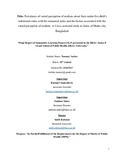Prevalence of varied perception of mothers about their under-five child’s nutritional status with the measured status and the factors associated with the varied perception of mothers. a cross-sectional study in slums of Dhaka city, Bangladesh
Abstract
Abstract
Objective: Childhood malnutrition is a serious public health concern as it hampers a child’s
physical and cognitive development. Maternal misperception about their child’s nutritional status
can increase the burden of malnutrition. There was very limited literature on maternal perception
of their under-five child’s nutritional status in Bangladesh. The purpose of this study was to
assess the burden of mother’s varied perception about their under-five child’s nutritional status
and associated factors of it in urban slum context.
Design: Cross-sectional study
Setting: Two largest urban slums one from the Dhaka south city corporation (Dholpur) and
another from Dhaka north city corporation (Korail).
Participants: A total of 437 mothers were included in the final analysis, of whom 215 were
from Dholpur and 222 were from Korail slum.
Primary outcome: Mothers’ varied perception about their under-five child’s nutritional status
was the primary outcome of interest. The varied perception is defined as the discrepancy
between the mother's opinion of their child's nutritional state and the measured nutritional status.
Results: The prevalence of mother’s varied perception was 45.8%. The prevalence was higher
for Dholpur slum compared to Korail slum (Dholpur 52.5% vs Korail 47.5%). 37.1% of mothers
underestimated their child’s nutritional status, while 8.7% overestimated it. “Child doesn’t want
to eat” (AOR=3.77; 95% CI: 2.35 to 6.05; p<0.001) and “feel light when I carry” (AOR=4.09;
95% CI: 2.01 to 8.34; p<0.001) was the significant reason behind the mother’s perception.
Mother’s monthly household income 10000 to less than 15000 BDT (AOR=2.41; 95% CI: 1.17
to 4.99; p<0.05) and 20000 to less than 25000 BDT (AOR=2.51; 95% CI: 1.10 to 5.71; p<0.05)
had significantly higher odds of varied perception.
Conclusion: The prevalence of varied perception about their child’s nutritional status was high
for the urban slums. Health education on appropriate feeding practices for children and MUAC
measurement can help mothers to perceive their child’s nutritional status more precisely. Further
qualitative research is required to explore maternal perception.

